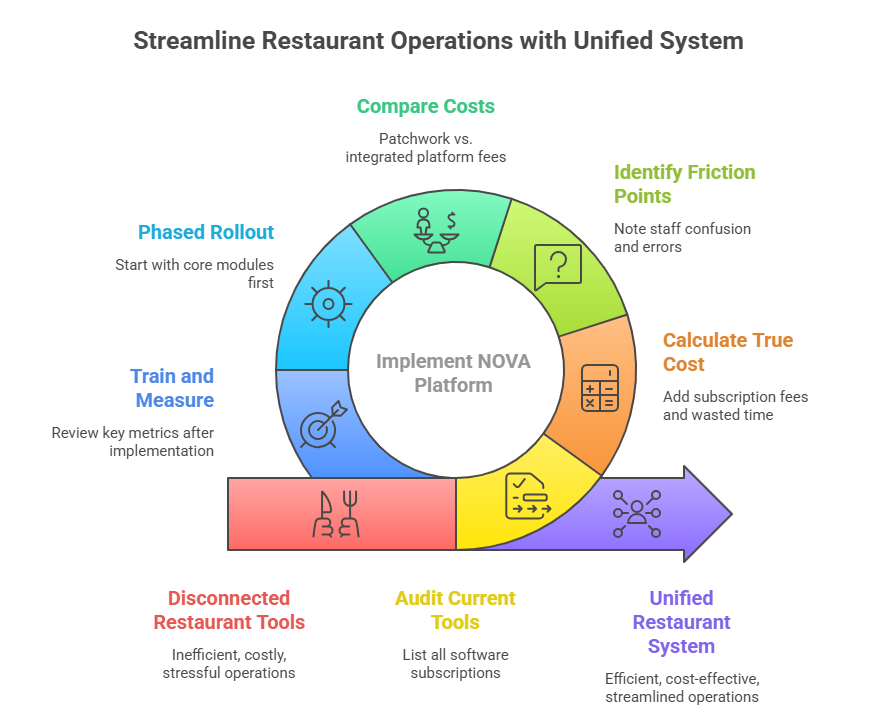
Your restaurant's greatest asset isn't the secret ingredient in your signature sauce or your prime location—it's your people. A happy, confident, and empowered team is the engine that drives exceptional hospitality. Yet, in today's tough labor market, restaurant owners are facing a crisis of burnout and turnover. While many factors contribute to this, one major, often overlooked culprit is the frustrating, inefficient technology your staff is forced to use every single day.
Think about the digital obstacle course you’ve created for them. They take an order on one of the many point of sale systems for restaurants, manage delivery requests on a separate, clunky tablet, check their schedule in a third-party app, and try to redeem a customer's loyalty points on yet another system. This "patchwork" approach, assembled with the best of intentions, creates constant friction, confusion, and stress. It forces your team to spend more time battling their tools than connecting with guests.
This daily struggle isn't just a minor inconvenience; it's a primary driver of job dissatisfaction that leads to higher turnover, increased training costs, and inconsistent service. This article explores how a fragmented tech stack impacts your most valuable resource—your staff—and reveals how a single, intuitive platform like NOVA can transform their work experience, boost morale, and turn your restaurant into a place where great employees want to stay.
The Daily Grind: A Day in the Life of a Technologically Tortured Server
To understand the human cost of bad technology, let’s follow a server, Sarah, through a typical busy shift.
Sarah arrives and first needs to check her schedule for next week. She pulls out her phone and logs into the restaurant scheduling software, a standalone app that has no connection to anything else. Then, she clocks in for her shift on the main POS terminal, a separate system.
Her first table is a party of eight. She carefully takes their complex order, complete with substitutions and allergy notes. She then has to walk across the busy dining room to the single, stationary POS terminal to enter everything. While she’s tapping away, a customer at another table is trying to get her attention to ask for the check. She finishes the order entry, but now has to remember the second request, creating a mental load that can easily lead to mistakes.
Later, a delivery driver comes in. The order is on a tablet perched precariously at the host stand. Sarah has to stop what she's doing, confirm the order on the tablet, and then manually re-enter a "to-go" order into the main POS so the sale is recorded correctly and the kitchen gets the ticket. This duplicate entry is not only a waste of time but also a prime opportunity for error. Did she remember the "no onions" modifier?
Towards the end of the night, a guest wants to pay with a gift card purchased online. The system for that is, of course, different from the main payment processor. Sarah and her manager spend five awkward minutes at the table trying to figure out how to process it, while the guest grows visibly frustrated.
For Sarah, this isn't a job focused on hospitality; it's a series of frustrating technological hurdles. She ends her shift feeling drained, not from serving guests, but from fighting with the tools meant to help her. This experience, repeated day after day, is a direct path to burnout.
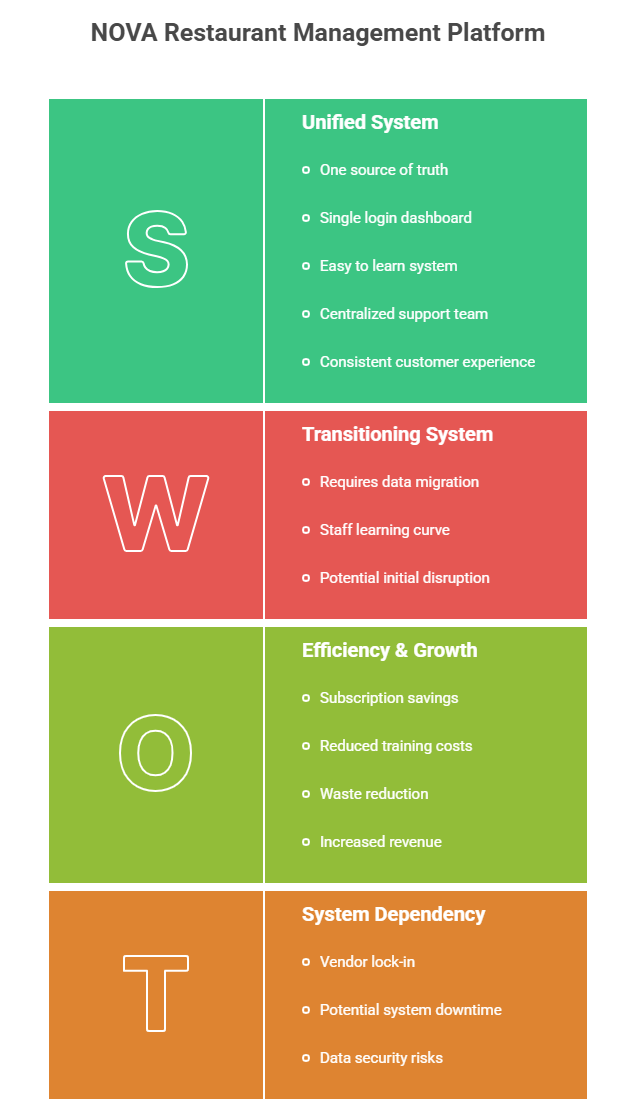
How Fragmented Tech Directly Impacts Your Team and Your Business
The "Sarah" scenario plays out in restaurants everywhere, creating a ripple effect of negative consequences.
The Nightmare of Onboarding and Training
With the industry’s high turnover rate, you are constantly training new employees. When your tech is a confusing patchwork of five or six different apps, this process becomes incredibly painful and ineffective.
Cognitive Overload: Instead of learning one intuitive system, new hires are bombarded with multiple logins, interfaces, and workflows. This steep learning curve is intimidating and often leads to them feeling incompetent and overwhelmed from day one.
Wasted Management Time: Your managers, who are already spread thin, are forced to become IT trainers. They spend hours repeating the same basic instructions for different systems, time that would be far better spent on coaching service standards, team building, and higher-level management tasks.
Inconsistent Performance: A poorly trained, unconfident employee is an error-prone employee. They will make more mistakes on orders, struggle with payments, and be unable to answer customer questions confidently, all of which reflects poorly on your restaurant.
The Morale-Crushing Effect of Inefficiency
No one likes to feel that their time is being wasted. Disconnected systems are masters of inefficiency, creating daily frustrations that destroy morale.
The Frustration of Wasted Steps: The constant back-and-forth between a table and a fixed POS terminal is physically and mentally draining. Servers using modern handheld ordering devices for restaurants can take orders, send them to the kitchen, and process payments without ever leaving the guest's side. This simple change can transform their workflow, allowing them to be more present and attentive.
The "Blame Game" of Tech Support: When the delivery tablet stops syncing with the kitchen printer, who is responsible? The POS company blames the delivery company. The delivery company blames your internet. Your staff is caught in the middle, unable to do their jobs while vendors point fingers. This feeling of helplessness is incredibly demoralizing.
Lack of Empowerment: Good technology should empower your staff to solve problems and delight guests. A fragmented system does the opposite. When a server can't easily split a check or redeem a loyalty reward, they feel powerless and incompetent, chipping away at their confidence and job satisfaction.
The Direct Link to Higher Turnover
Employees who are happy and feel effective at their jobs are far more likely to stay. When their primary tools are a source of daily frustration, it becomes a major factor in their decision to leave.
Increased Stress and Burnout: Battling clunky technology shift after shift is stressful. This added stress, on top of the already demanding nature of restaurant work, accelerates burnout.
A More Attractive Offer Elsewhere: When a competitor down the street uses a sleek, modern, all-in-one system that makes the job easier, your restaurant suddenly looks like a less appealing place to work. Smart, efficient technology is becoming a competitive advantage in the hiring market.
The High Cost of Replacement: The cost to replace an employee can be as high as $6,000 when you factor in recruitment, hiring, and training. Reducing turnover by even 10-15% by providing better tools can result in tens of thousands of dollars in annual savings.
The Solution: A Unified Platform Designed for People
The best way to support your team is to give them tools that work for them, not against them. A modern, all-in-one restaurant management software platform replaces a dozen points of friction with one seamless, intuitive experience.
How a Single System Transforms the Employee Experience:
One System to Learn, One Way to Work: Training becomes exponentially faster and simpler. New hires learn a single, consistent interface for every task, from clocking in to taking payments. This allows them to build confidence quickly and focus on learning what really matters: your menu and your guests.
Workflows that Flow: With tools like table side ordering, orders are fired to the kitchen instantly and accurately. Delivery orders from all platforms appear directly in the POS, eliminating the need for extra tablets and manual re-entry. Payments are processed in seconds at the table. The entire service becomes smoother and less stressful.
Information at Their Fingertips: An integrated system gives servers the information they need to succeed. They can see item-level inventory counts to know if a dish is running low. The POS can prompt them with smart upsell suggestions. They can look up a customer's loyalty status and past orders to provide personalized service.
Clear and Easy Communication: A unified platform with integrated restaurant back of house software modules means everyone is on the same page. The front-of-house sees the same real-time inventory as the kitchen. Managers can send messages to the whole team through the system. Scheduling is transparent and easy to manage.
NOVA: Built for Your Team, Loved by Your Guests
At NOVA, we believe that technology should feel effortless. We designed our all-in-one platform with the end-user—your staff—as our top priority. The interface is clean, modern, and as easy to use as their favorite smartphone app.
Intuitive POS: Our core restaurant POS systems are designed for speed and simplicity, minimizing the number of taps required for any action.
Effortless Scheduling: Our built-in scheduling tool allows managers to create and publish schedules in minutes. Staff can easily view their shifts, request time off, and swap shifts with manager approval, all within the same app.
Empowering Handhelds: Our handheld devices are lightweight, durable, and run the full version of our software, putting the power of the entire system in your servers' hands.
One-Stop Support: When your team needs help, they have one number to call. Our support team understands the entire platform and is empowered to solve problems quickly, so your staff can get back to serving guests.
Restaurants that switch to NOVA consistently report happier, more efficient teams. Managers tell us they save up to 50% on training time, and staff rave about how much less stressful their shifts have become.
Making the People-First Transition
Moving to a new system should be a collaborative process that energizes your team.
Get Staff Feedback: Before you do anything, ask your team about their biggest technological pain points. What frustrates them the most? What wastes their time? Their answers will highlight the most urgent problems to solve.
Involve Them in the Demo Process: Let your key staff members (a lead server, a bartender, a shift manager) participate in demos. If they are excited about the new system, adoption will be much smoother.
Prioritize Ease-of-Use: When comparing systems, make user-friendliness a top criterion. A system with a million features is useless if your staff finds it too complicated to use.
Invest in Proper Training: While a unified system is easier to learn, proper training is still essential. A hands-on training session will ensure everyone feels confident and ready from day one.
Celebrate the Improvement: After the launch, highlight the positive changes. Point out how much faster service is, how order accuracy has improved, and how much stress has been eliminated.
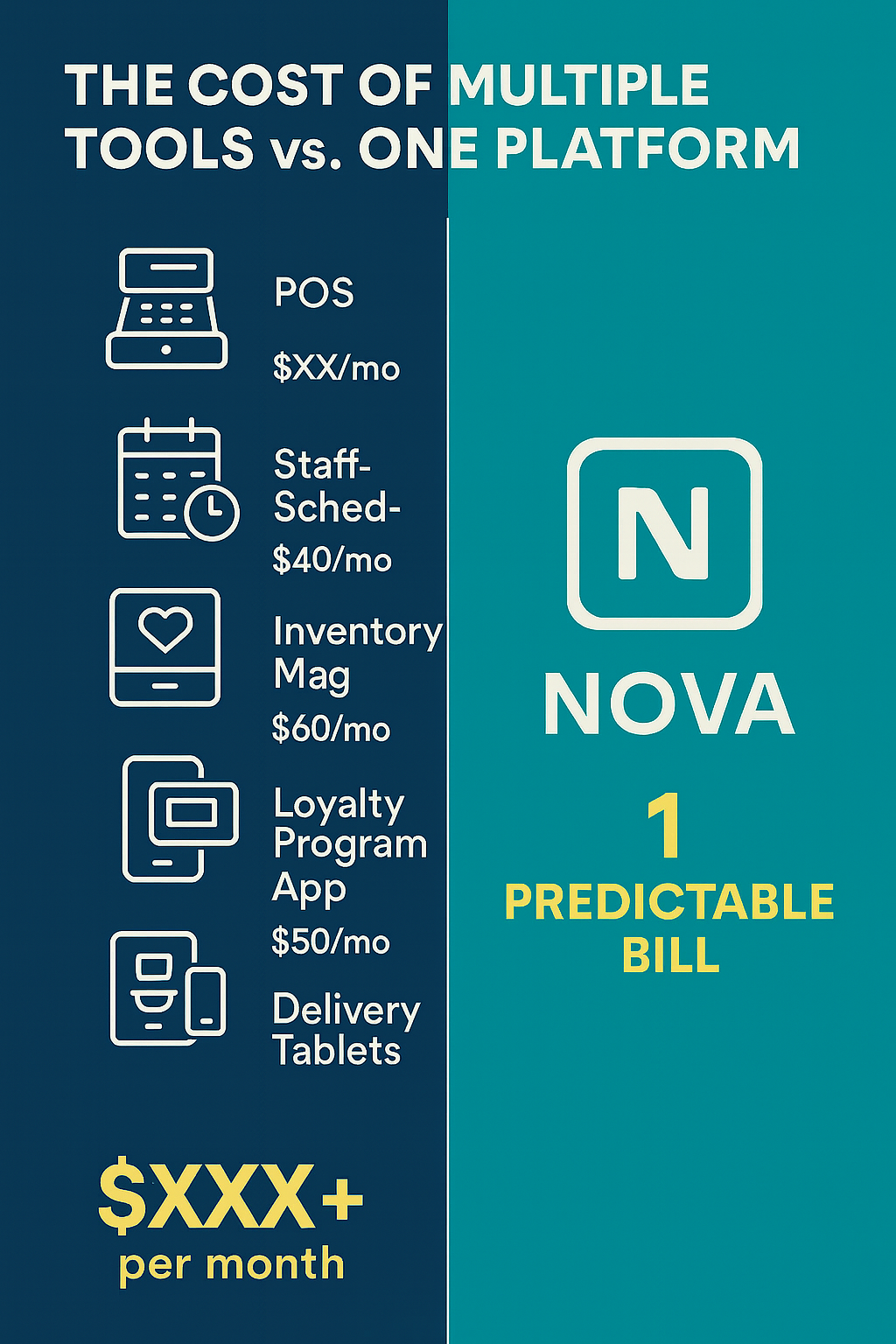
Conclusion: Invest in Your Team by Investing in Your Tech
Your employees are on the front lines every single day. Forcing them to wrestle with a clunky, disconnected set of tools is a recipe for frustration, burnout, and costly turnover. You can't afford to let your technology be a barrier to great hospitality.
Switching to a unified, all-in-one platform like NOVA is one of the most powerful investments you can make in your team. It removes the daily friction, empowers them with efficient workflows, and frees them up to do what they do best: create amazing experiences for your guests. When you give your team the right tools, you create a happier, more productive workplace, which translates directly to happier customers and a healthier bottom line.
Ready to give your team the tools they deserve? [Schedule a demo of NOVA and see how a user-friendly platform can transform your restaurant.]




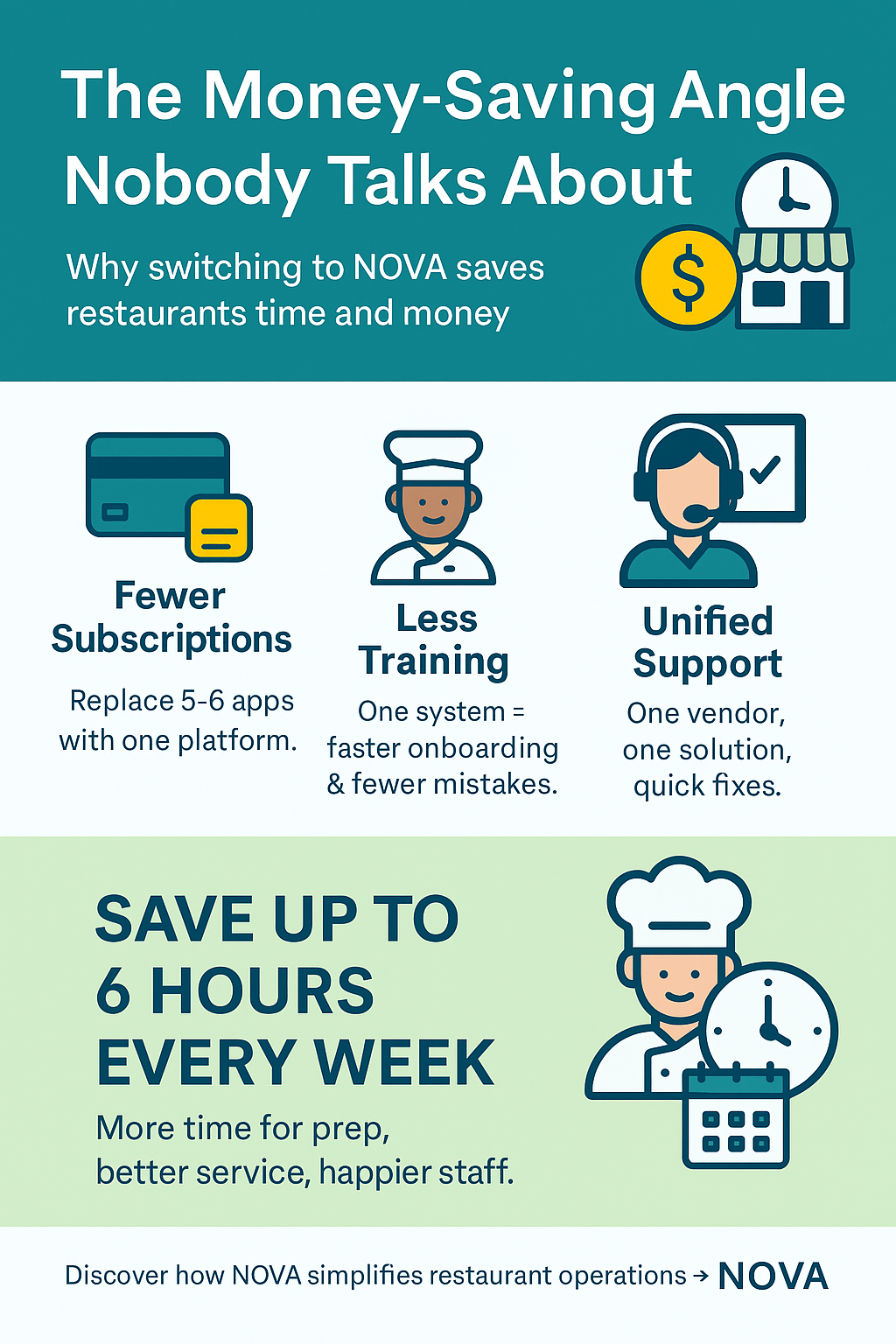

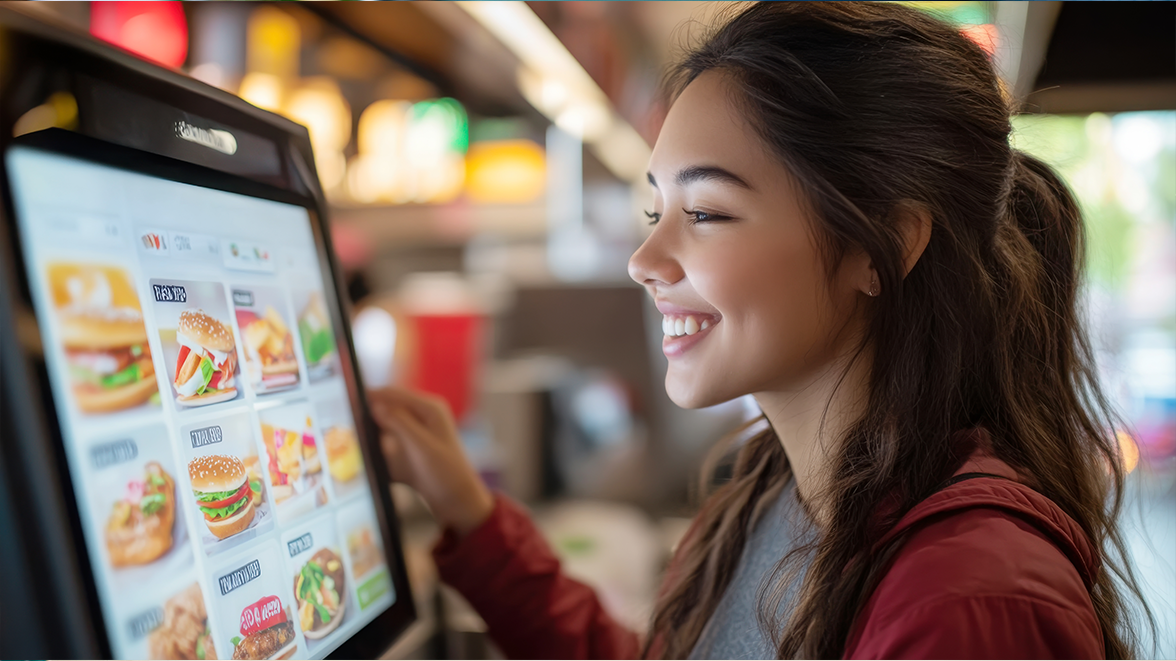
Write a comment ...